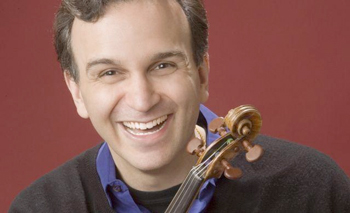by Daniel Hathaway

Daniel Hathaway: We enjoyed hearing the Korngold over the radio from Miami, and considering the weather here, we really wished we’d been there in person.
Gil Shaham: I felt very lucky to be there with Franz and The Cleveland Orchestra. It’s been a few years since I’ve played the Korngold. It’s beautifully written and the composer gets really wonderful sounds from the violin and the orchestra.
DH: It must be fascinating to play it with different conductors.
GS: That’s so interesting. With Franz it had a beautiful, Viennese lilt, which is really true of all of Korngold’s music. The concerto had a feeling of triple-meter dancing with beautiful, subtle colors. John is much more concerned with compositional details. Should these be whole-tone or half-tone trills? With accents at the beginning? A series of single lines or a series of accents? But I learn so much from everyone. When I was a kid, 11 or 12, I visited the shop of the wonderful luthier René Morel. He told me, “Gil, I can see that you will be a great violinist. I can tell because you are always listening to what people are saying, and you try to learn from it.” Well, now I realize he was saying that just because I wasn’t listening. That was a very kind way of saying, “Hey, listen up.” Now that I’m middle-aged I think he was right. You really can learn so much by listening to everybody around you.
DH: Let’s talk about Bach. I believe you’ve previously played all six Suites and Partitas in a single marathon program. What was that like?
GS: I did that a couple of times and I was very worried about it before. The truth is that there is no greater joy than playing Bach, and many other musicians — like András Schiff — say that too. There’s something so satisfying, so uplifting, so rewarding, so fulfilling. There’s so much to say about this music. I go to the practice room and set aside an hour, and inevitably, two hours later I’m still playing. It’s next to impossible to tell what Bach was thinking.
The solo works are so interesting because Bach transcribed movements for other purposes. The E-major Prelude became the Sinfonia for Cantata 29. He reworked the a-minor Sonata for oboe and strings. The fugue of the g-minor Sonata became an organ piece. There’s a beautiful story about Bach visiting Reincken in Hamburg and playing that fugue. Reincken told Bach that he thought that art was long dead but that Bach was carrying it forward.
DH: You’ve been quoted as saying that you learned the Bach pieces early on but never thought of performing them until recently. With the rise of the Historical Performance movement in the meanwhile, has your approach to playing them changed?
GS: Already many people were interested in historical performance. I still love and recommend the Bach recordings by Sergiu Luca. I do feel that nowadays we have much more freedom in playing Bach than ever before. I hear the different choices people make. For my own mid-life crisis I carry around a baroque bow and experiment with different bridges and strings. In general, I use faster tempos. In the case of the Ciacona, I’m lucky to have heard chaconnes by composers like Monteverdi and Fux. Without exception, all of those are played much faster than I used to play the Bach. It’s the same with the Sarabande in the d-minor Partita, and with the fugue we talked about. I used to play that fugue very deliberately, but now I play it faster. That research has helped me a lot.
DH: And will you use a Baroque setup for your Cleveland recital”
GS: I might! I wish I’d decided already!
Gil Shaham will play J.S. Bach’s Sonata No. 2 in a, BWV 1003, Partita No. 2 in d, BWV 1004 & Sonata No. 3 in C, BWV 1005 on Thursday, February 6 at 7:30 in Gartner Auditorium at the Cleveland Museum of Art. A 6:00 pm pre-concert talk on “Rare Italian Violins” will be given by Philip J. Kass, curator of string instruments at Philadelphia’s Curtis Institute of Music.
Published on ClevelandClassical.com February 4, 2014
Click here for a printable version of this article.



